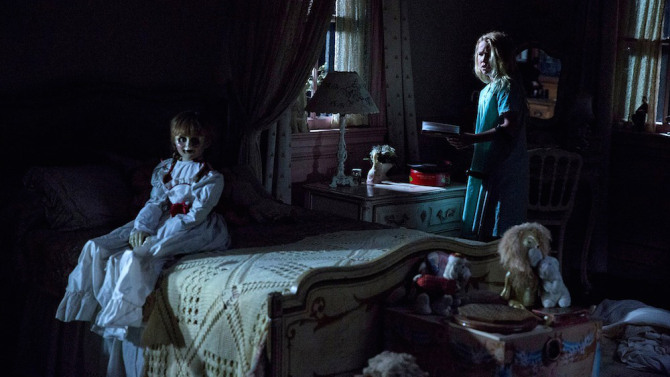
Though good on atmosphere and performances, Annabelle: Creation is slowly paced and short on scares
On paper, horror prequels shouldn’t work. Especially horror prequels in a pre-existing cinematic universe. Because when a film turns to prequels instead of sequels, it generally means the plot is capital-T Taped Out. But with Insidious: Chapter 3, Ouija: Origin of Evil and now Annabelle: Creation, horror prequels are treated not as a constraint, but embraced as an opportunity to tell more tales about how something in the first installment—a demonic presence, an evil entity, or a doll as a conduit for evil—came to be.
The first Annabelle did incredibly well at the box office so it’s no surprise a sequel was quickly announced. But what to do with the titular doll with eerily human features, muddled porcelain skin, and red-bowed pigtails? Annabelle already linked to The Conjuring where the doll ended up in a glass case in Ed and Lorraine Warrens’ basement, so where could a future installment go? Even with using retroactive continuity, how exciting (and plausible) would it be to go through the same motions of the first film with Annabelle in the possession of a new couple or family?
And so, with the subtitle Creation, we go back to the beginning when Annabelle was, well, created. I had been wondering how it would tie into the original, so the film gets bonus points for not taking the easy way out with retroactive continuity. Both films link together creatively and seamlessly without making the viewer feel cheated. (The Easter eggs to The Conjuring universe are pretty fun, too.)
The story picks up 12 years after the Mullins family lose their young daughter Annabelle (see where this is going?) in a car accident. Hoping it will give them some peace, they decide to take in a group displaced orphan girls. Among them are Janice (Talitha Bateman) and Linda (Ouija: Origin of Evil’s Lulu Wilson). They’re good friends, though feeling despondent they’ll never get adopted. Everything about their new home—from their joy over having a TV and radio, to the rooms that make it feel like a mansion—seems too good to be true. That is, until they find the Annabelle doll in a locked closet. This sets off a chain of events inexplicable to the young girls—the lights go out, Janice is locked in her room, the ghostly figure of Annabelle Mullins appears, and the doll itself is found moved around the house. What’s going on? Is Annabelle Mullins’ ghost haunting them? Is it another entity entirely? If you’ve seen the first installment (or either Conjuring films) you can probably guess the answer.
Though creative with its prequel story and link with Annabelle, unfortunately, Creation is a little short in the scares department. Though there are a few good, innovative ones (a creepy scarecrow; Janice’s wheelchair being pushed; the transforming figure of Annabelle Mullins), because most of the scares are familiar, there’s not really many that made an impression on me. Creation is pretty light on tension as well, which is what the first Annabelle did so successfully. With its utilization of lingering shots on everyday objects to make us feel uneasy, quick cuts to ratchet suspense, and playing with our—and the characters’—perceptions of reality, it seemed to understand that scares come not from creaking doors and creatures springing from darkened rooms, but from the careful building of tension. It also made good use of the doll itself. Annabelle’s John Leonetti lingered on it uncomfortably, showed it from multiple angles in multiple locations, as well as putting it in locations (i.e. a rocking chair) to create movement. But in Creation, instead of ratcheting up the creepiness and unease around her, more attention is given to the entity believed to be attached to it than Annabelle itself.
But despite the lack of genuine, innovative scares, the film’s atmosphere and locations (the many rooms of the Mullins’ house, barn, and yard) are very well done and fully immersive, the isolated locations making the viewer feel the characters’ seclusion and claustrophobia. It’s also well shot and directed, David Sandberg (Lights Out) managing to get great performances from all the actors, especially Talitha Bateman and Lulu Wilson whose shared friendship and fears both feel genuine.
The story, on the other hand, moves too slowly. I love and admire that Sandberg allowed the opening half to breathe by developing the characters, but it really did seem to drag, almost as if it knew it didn’t have enough scares and had to ration them. I almost wish it would’ve simplified the film even further by focusing on the Mullins and their lives after losing Annabelle since it seemed like the most interesting things about them—their suffering and horror—happened before the film started. Plus, I love Miranda Otto so wish she and her character were utilized more.
I didn’t like Annabelle: Creation nearly as much as I enjoyed the first installment. Despite its great performances and atmosphere, it’s slowly paced and high on jump scares. Though the series’ box office receipts prove that Annabelle continues to draw intrigue, now that we’ve seen both her beginning and end, it may be time to put her back in her wooden case and move onto the next file in the Warrens’ caseload.
7/10